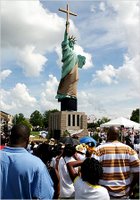
The unveiling of this 72 foot tall statue in Memphis (NY Times) seems as good as time as any to make an update on the state of the U.S. Megachurch. According to this fantastic 2005 summary by the Hartford Institute for Religion Research, the number of megachurches (defined as having a weekly attendance of at least 2,000 people) has doubled in the last five years to around 1,200 across the country. The average attendance for a megachurch is about 3,500 people and are mostly concentrated in four states: California (14%), Texas (13%), Florida (7%) and Georgia (6%). Interestingly, 83% of churches said that they have grown under the leadership of a single pastor (typically 50 years old and well-educated) with a average staff of 35 people who serve 30 to 40 hours a week as volunteer leaders.
And of course, a few of these churches are building colossal monuments like this one as a major attraction:
Probably most importantly, is to note the Eleven Misconceptions at the end of the summary article, most notably that these congregations have high spiritual expectations and that these churches grow simply because "excited attendees tell their friends." This can all be wrapped up by this King of the Hill episode clip on Megachurches:
Props to Church Marketing Sucks
Share ideas that inspire. FALLON PLANNERS (and co-conspirators) are freely invited to post trends, commentary, obscure ephemera and insightful rants regarding the experience of branding.
Thursday, July 06, 2006
State of the Megachurch
Subscribe to:
Post Comments (Atom)















2 comments:
I went to one of these churches once and it was a really different experience. The "contemporary" service is more dominant (Kumbyah with a rock beat), technology is everywhere (big screens, sound, 5 piece band, video, etc.). The pastors could easily be motivational speakers - they really know how to work the audience. It was...an entertainment experience (albeit a little creepy to me, coming from a smaller traditional congregation). Very American. I think the principle reason for the success of these is they serve as a complete replacement for the tight-knit communities of yesterday. They have their own education programs, sports teams, entertainment, music training, etc. A one-stop shop for many. Also, the day I went, they were working on "this months" fund drive for an African food program. Their goal was like $85 grand - for the month. For most churches, that's an annual goal. Thus, I suspect the scale of these places also pays emotional dividends for the congregation in that they feel like they are part of something with clout. $85 grand feeds a lot of Africans. I believe that Putnam's premise is a bit off in that yes, we have lost traditional social capital building associations but we have simply replaced them with alternates.
Black churches are going mega, too. In fact, to your point, Stan, many of the black congregations who actually live in the city, still commute on Sundays to the suburbs to a newly built, shiny MegaChurch.
So those quaint urban affairs in the 'hood are getting left behind (they are hardly sexy in comparison), or consolidating their monies to relocate Mega in other suburban communities (using the roads+sewers+other public resources+benefits) while not necessarily bringing any tax base or commercial benefit to those 'burbs (but consider the old paradigm where day workers exploited the downtown resources then escaped to the 'burbs by nite and weekend, leaving the urban center void of any tax base or commercial base).
Of course, many suburban neighbors are getting angry at these transplant worshipers and new tensions are brewing.
Post a Comment